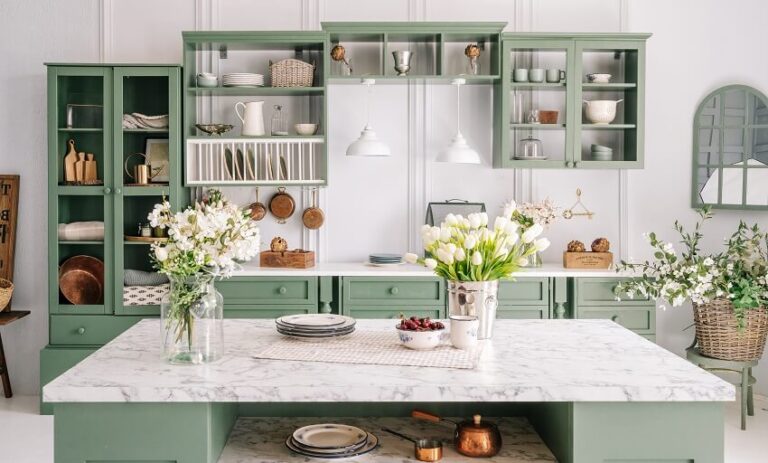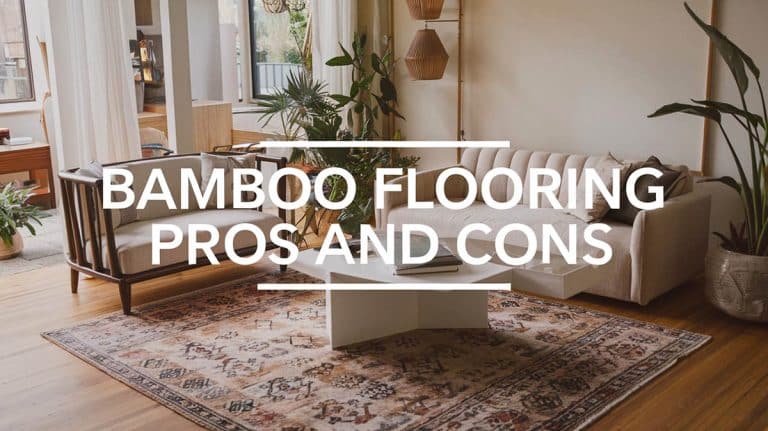Cork Vs. Bamboo Flooring (Comparison Guide)
Here’s our cork vs bamboo flooring comparison including what they are, differences in look & feel, durability, cost, maintenance and installation.

Cork flooring has been around for decades. Although they’ve been deemed as somewhat outdated, they’ve made a major comeback ever since and is actually all the rage right now. This is mostly because they’re considered to be a green and renewable material.
It means that the resource can be consumed without the guilt and environmental repercussions that usually come along with hardwoods and tropical rainforests. And speaking of renewable resource, bamboo floors happen to be another option available.
This now leads to people wondering which one between the two is better. Both of them are green, sustainable, and renewable. However, depending on what your preferences are, they have major differences that just might tip your opinions towards one or the other.
What Is Cork Flooring?
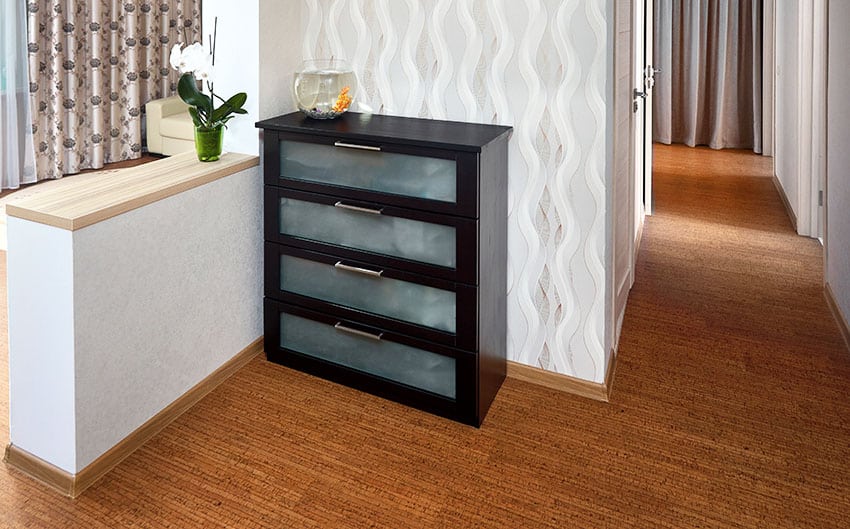
Cork flooring is a material that can be completely replenished. It’s renewable, recurring, and is also 100% natural. It’s a flooring material that’s actually quite ideal because of the durability and versatility it can offer compared to the rest of the other traditional flooring materials available on the market these days.
Cork is sourced from the bark of the cork oak tree. This is grown in plantations and is harvested in periodical schedules. After that, the trees are left to regrow their barks, ensuring that the material can be harvested over and over again.
The harvested material is then ground up, and then mixed in with bonding agents and resins, until they’re compressed and processed out as planks that can then be converted into flooring material.
Cork floors are trendy and durable and they’ve actually grown quite popular over the years. This is because of the green movement.
More and more people are now environmentally aware and would want to go with home construction materials that don’t end up harming the environment and cork happens to tick all of those required boxes.
They also have a very distinct appearance to them that appeals to certain aesthetics so that’s another notch up for cork flooring materials as well.
What Is Bamboo Flooring?
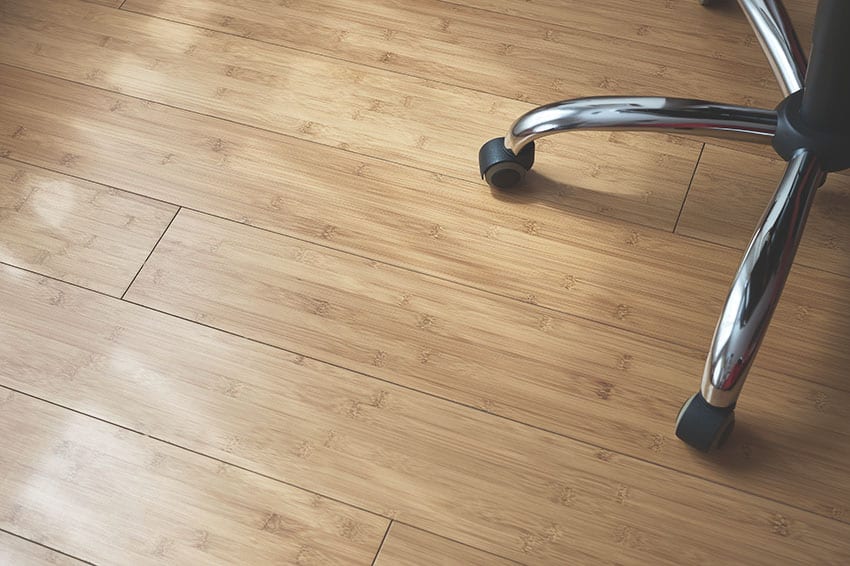
Bamboo flooring is a great alternative to consider to traditional hardwood materials for flooring options. They have physical traits that make them pretty similar to hardwood but by and large, they are actually more sustainable, friendlier on the environment, and surprisingly, far more durable.
Bamboo, however, isn’t technically a type of wood. It’s a type of grass. How the material is processed is that they are cut down into strips, cured, and then compacted into plank materials. They offer options and versatility in terms of finishes, colors, and even in terms of the styles that they come with.
Bamboo floors are prized because they’re dimensionally stable but light. They can be put down in areas with major humidity fluctuations because they can withstand it. They can be installed along with underfloor heating.
They can even be floated above an underlay. They’re pretty flexible which makes them a truly viable option especially for redecoration efforts.
Cork Vs Bamboo Comparison
Comparing cork and bamboo flooring side by side is tedious but knowing exactly what’s in it for you will better educate you on what features and benefits you like better. This can aid you in deciding on whether you would ultimately want to go for either cork flooring or bamboo flooring.
Look & Feel (Bamboo wins for looks, Cork wins for feel)
Bamboo flooring: When it comes to the look and feel, nothing quite compares to stepping on bamboo flooring barefoot. It gives warmth on a cold day.
Bamboo also has a lot of air pockets trapped in between its fibers which means that on a hot day, it doesn’t get hot all too quickly. The overall result of this is getting floors that are nice to walk on that has a certain amount of climate control in it as well.
Cork flooring: Cork flooring is a much more superior thermal insulator compared to bamboo. It is soft on the feet and can even be quite springy as it tends to bounce back when weight is applied to it. It is far more comfortable to walk on compared to bamboo flooring.
Cork planks also have high porosity in them which means that similar to bamboo, they too have air pockets inside, making them great for climate control and for getting walked on in general.
Durability (Bamboo is stronger)
Bamboo flooring: In terms of durability, bamboo has to take the cake on this one. Bamboo is surprisingly hardy and durable considering that it isn’t technically a type of wood. For a grass variant, it holds itself up pretty well.
As a matter of fact, high quality strand woven bamboo planks have been known to be the strongest natural construction material. That’s a lot. And this is why bamboo wins in terms of durability with little to no contest at all.
Cork flooring: Cork can be made durable with the proper pre-treatment, maintenance, and periodic sealing. However, it does have a certain softness to it that can make it pretty susceptible to heavy furniture, sharp objects, and the like.
So although it’s still a pretty good contender as a flooring material compared to the rest in the market, it doesn’t really compete or come close to the durability that bamboo will be able to over your floors at home at the end of the day.
Hardness (Bamboo wins)
Bamboo flooring: Bamboo is interestingly very resistant to denting and is considered to be a very tough material. As a matter of fact, it’s harder than most hardwoods being marketed right now. Strand woven bamboo in particular, tops the list. It’s known to be one of the toughest flooring materials out of the natural materials available.
Strand woven bamboo has a hardness of 4000 on the Janka Hardness scale while natural bamboo has a rating of 1500+. Engineered bamboo also ranks more or less the same.
Cork flooring: Cork is a material that’s naturally soft. In the Janka Hardness rating scale, it only has a score of 200. However, despite its naturally soft consistency, this isn’t technically a bad thing for cork flooring as it’s an elastic material. When dented or bent out of shape, it can easily bounce back to its original shape. It does have an elasticity limit though and once that has been exceeded, this can lead to deformations.
Walking around cork flooring in sharp heeled stilettos, for example, can end up permanently damaging it. Heavy furniture can also have the same effect.
Water Resistance (Cork wins)
Bamboo flooring: Bamboo is a material that’s highly water resistant but it isn’t technically waterproof. It is more water resistant compared to most of the hardwoods out there though, so that’s a definite plus.
Bamboo floors will be able to resist water damage despite being soaked in a water puddle for 24 hours or so. However, it’s recommended that the water isn’t left out for much longer than that as this can cause the material to discolor, swell up, and eventually show signs of permanent damage.
This means that you can use bamboo flooring in most of the spaces in your house but it isn’t recommended to be used in bathrooms where water pooling is almost always happening.
Cork flooring: Cork is very water resistant, which is actually why it’s used to seal wine bottles and other beverages. This is mainly because of its naturally water resistant material called Suberin. Suberin has hydrophobic qualities to it.
The weakness though is in the seams of cork flooring. Once immersed in water, the adhesive used to attach the cork material to the floor can be damaged. This is why it’s highly recommended to get cork floors sealed right after installation.
Cost (Tie!)
Bamboo flooring: Bamboo is surprisingly cheap. To this day, it still astounds people how it can easily rival hardwoods in terms of strength and durability but only come up to only a fraction of its cost.
A mature bamboo is ready for harvesting in only under 5 years whereas hardwoods take 25 years. Premium bamboo planks that can be made into floors is readily available and usually come at very reasonable and far costs.
Cork flooring: Cork takes 25 years to mature but once they’re there, you can re-harvest from it every 9 years or so. Cork comes in abundant supply and although they were originally meant to sustain the wine industry, there’s a lot to go around to supply cork flooring material needs.
Due to its surplus in supply and the fact that it’s a renewable resource, it’s just as cost friendly as bamboo floors.
Natural (Tie!)
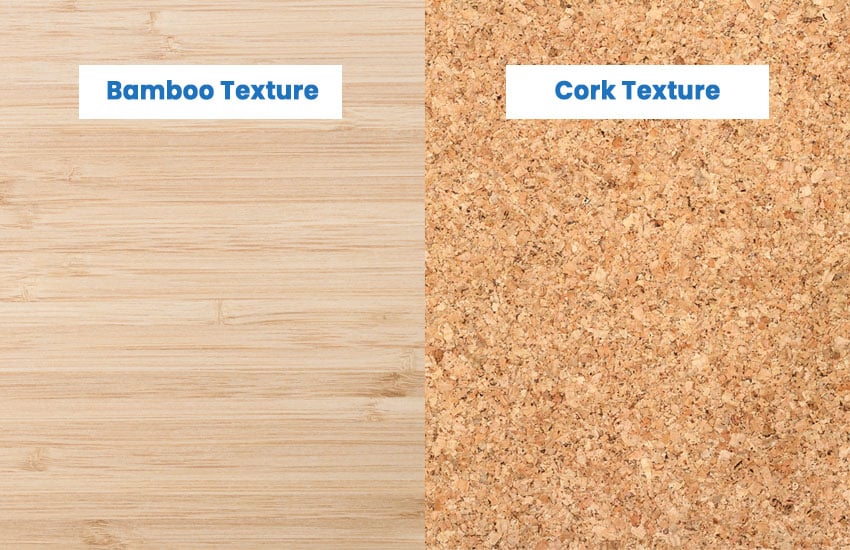
Bamboo flooring: Bamboo flooring materials come with natural grains and strands that are unlike hardwood but can look very similar to it. This is because bamboo is mainly fibrous.
No bamboo planks are exactly alike. They are each unique with their own patterns and this results to a very natural and authentic look for your floors.
Cork flooring: Cork doesn’t have the same grain-like traits that bamboo offers because its texture makeup is completely different. It is still unique though and no single cork tile or plank is exactly the same.
You will never find repeating or similar patterns with cork. It does offer a completely natural look and because of its variations, it still comes off looking perfectly natural.
Eco-Friendly (Tie!)
Bamboo flooring: Bamboo is easily considered as the most sustainable construction material on the planet. It has a considerably lower eco cost compared to most hardwoods and it tends to grow very fast. (It’s technically categorized as a type of “grass”, after all).
Bamboo can be harvested in as short as 5 years after getting it planted. Harvesting bamboo is also eco-friendly. It doesn’t damage the surrounding ecosystem and more importantly, it doesn’t cause erosion.
It takes in more carbon dioxide than any plant or tree ever can which means that it can definitely actively reduce global warming especially when planted on a large scale.
Cork flooring: Cork is also a highly sustainable material. Since it’s made purely out of the cork oak tree’s bark, it means that the material can be harvested without ever getting the main tree cut down.
Once the bark has been stripped from the tree, the tree is left alone to continue to grow and eventually regrow their barks for more harvests in the future.
Cork oak trees take a long time to mature though. It would usually take them 25 years or more before they are ready for bark harvesting. It would then take them another 9 years or so to regrow their barks fully.
Still, these aren’t bad numbers given the fact that most cork oak trees could live well over 200 years. They are also naturally pest and insect free so this means there’s never a need for pesticides that could deplete or pollute the surrounding area’s water table.
Air Quality (Best for off-gassing depends on manufacturer)
To understand the context of off-gassing, it refers to the natural chemicals they emit that could change the quality of the air that we breathe in. These substances are called VOCs or volatile organic chemicals.
Although natural, they are considered as air pollutants and something that ought to be considered when you’re picking out materials to use for your floors.
Bamboo flooring: Bamboo flooring is a material that has very minimal VOC content. A majority of its content comes from the urea-formaldehyde cocktail that’s usually used for its adhesive to bind the bamboo strands together. They are so minimal though that they are barely negligible. They pass even the strictest air quality guidelines.
Cork flooring: Cork isn’t completely free from VOCs either. As a matter of fact, it comes with quite a list: phenol, acetic acid, formaldehyde, 2-ehtyl-1-hexanol, and 2-furfuraldehyde. Their levels are pretty low though and are still safely within government guidelines for safe air quality.
Maintenance (Nod to bamboo)
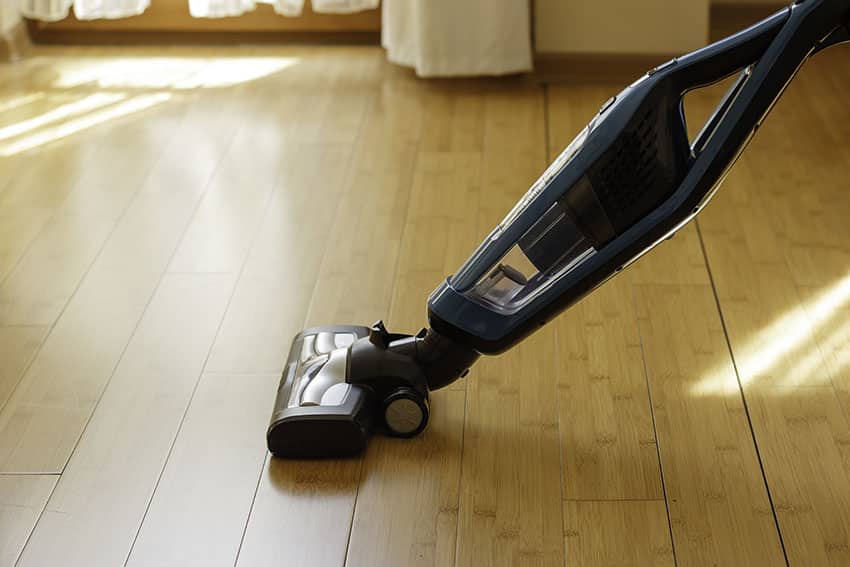
Bamboo flooring: Maintaining bamboo flooring usually doesn’t require anything more than basic vacuuming and sweeping. It’s important to make sure that your bamboo floors are constantly free from any dirt and debris.
This could result to getting the bamboo surfaces scratched which can damage the overall appearance in the long run. You can also opt to get the surfaces deep cleaned with some wood floor cleaner if you want it to be completely spic and span.
Cork flooring: The maintenance for cork flooring is pretty similar to bamboo flooring. Similarly, all it really needs is vacuuming, sweeping, and occasionally, some deep cleaning.
The only difference between the two is that every year or so, for best results, it is recommended to reseal your cork flooring to maintain its water resistance and to further prolong its life span.
Installation (Cork flooring wins!)
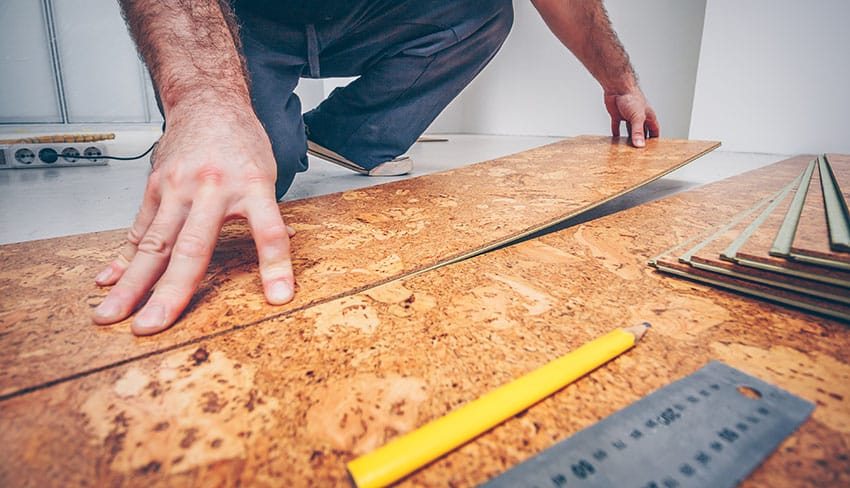
Bamboo flooring: The installation of bamboo flooring is within any DIYer’s skill for as long as they are fairly advanced. All you really need to do is make sure that you thoroughly read over the guidelines and instructions coming from the manufacturer and you should be armed and ready to install your bamboo floors yourself.
The installation guide is pretty easy to understand and with basic carpentry skills, this shouldn’t be too hard to follow through on. If you aren’t that comfortable or confident in your DIY skills though, it would still be best to get it installed professionally.
Cork flooring: Cork flooring is fairly easy to install. It usually just requires you to slap on some adhesive and glue your cork floor planks to either a flat and dry concrete subfloor, or to a plywood overlay if your existing floor is something other than basic and plain concrete.
The last step to this is sanding it down and getting the cork flooring polished. If you want an extra layer of protection, you can coat your cork floors with a sealer. No other floor installation could ever be simpler so cork flooring wins when it comes to installation.
What is your favorite when it comes to cork vs bamboo flooring? Let us know in the comments section. For more content like this see in our article about bamboo countertops on this page.



